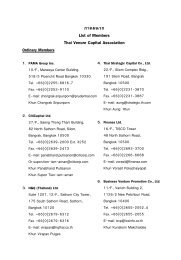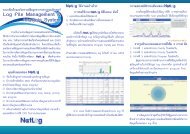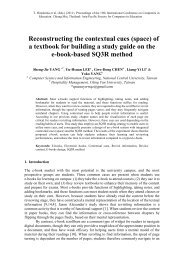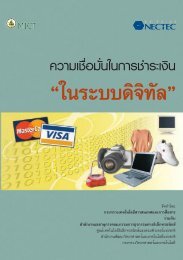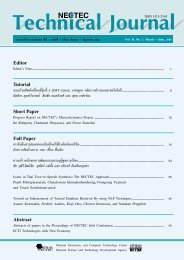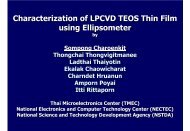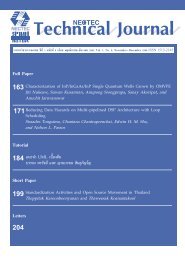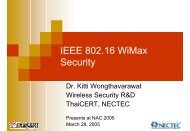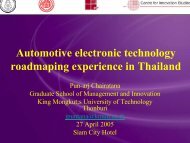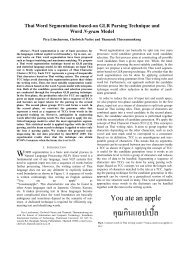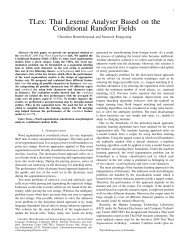ICCE 2009 Publications Format - Nectec
ICCE 2009 Publications Format - Nectec
ICCE 2009 Publications Format - Nectec
Create successful ePaper yourself
Turn your PDF publications into a flip-book with our unique Google optimized e-Paper software.
T. Hirashima et al. (Eds.) (2011). Proceedings of the 19th International Conference on Computers inEducation. Chiang Mai, Thailand: Asia-Pacific Society for Computers in EducationSupport for Concept Map Building based onLearner’s Building HistoryYouhei MIZUTA * , Tsukasa HIRASHIMA & Hideo FUNAOIGraduate school of Engineering, Hiroshima University, Japan*mizuta@isl.hiroshima-u.ac.jpAbstract: In the framework of kit-build concept map, (1) a goal map is prepared by ateacher, (2) parts of the map is generated by decomposing the goal map, and then, (3) alearner makes a map (a learner map) by combining the parts. The learner map is diagnosedby comparing with the goal map. The differences between the learner map and the goal mapshould be resolved by the learner to complete the learner’s map building. In this research, wehave investigated a way to support the learner to resolve the differences. Based on theanalysis of learner’s map building behavior, we have proposed three kinds of hints forlearners, that is, (I) concept group-centered building, (II) specific concept-centered building,and (III) recently connected concept-centered building. We have implemented a function togenerate these hints based on the learner’s building history and conducted a preliminaryevaluation of the function.Keywords: Kit-Build Concept Map, Map Building History, Hint for Map BuildingIntroductionConcept map is an useful tool to promote learners to describe their knowledge orunderstandings by themselves [1]. From the viewpoint of teaching, the concept maps builtby learners are promising products to examine the learners' understandings [2-6]. Diagnosisof concept maps built by learners, however, remains as a big issue to realize educationalinteraction through the concept map. We have already proposed a "Kit-Build Concept Map"as an approach to realize automatic diagnosis of concept maps [7]. In the framework ofkit-build concept map, (1) a goal map is prepared by a teacher, (2) parts of the map isgenerated by decomposing the goal map, and then, (3) a learner makes a map (a learnermap) by combining the parts.In this paper, a way to support the concept map building is explained and animplementation of the support function is introduced. Results of a preliminary experimentof the support function are also reported.1. Support for leaner’s map buildingIn kit-build concept map, errors of a learner map can be detected by comparing the learnermap with the goal map. Because the detected differences should be solved by the learner,the differences are targets of the support. In kit-build concept map, all nodes and links arecorrect ones. Therefore, the errors in a learner map appear as wrong connections. The wrongconnections, then, are classified into two types, one is an “incorrect connected link” and theother is an “unconnected link”. In this paper, only the support for unconnected links is dealtwith. In kit-build concept map, there is a correct pair of nodes corresponding to anunconnected link. Therefore, as an indication of the pair of nodes, a hint to an unconnectedlink is given. As for the incorrect connected link, it is necessary to take off the link first and
T. Hirashima et al. (Eds.) (2011). Proceedings of the 19th International Conference on Computers inEducation. Chiang Mai, Thailand: Asia-Pacific Society for Computers in Educationthen to connect it correctly. Because the support for an incorrect connected link is advancedone, we consider it for our future work.Usually, in the diagnosis of a learner map during the process of map building, there aremany unconnected links are detected. Therefore, it is necessary to select an unconnectedlink as the target of the support. Through the analysis of learners’ map building, we foundthree types of typical building behavior, that is, (I) concept group-centered building, (II)specific concept-centered building, and (III) recently connected concept-centered building.Because these three building behaviors are natural, it would be better to promote thesebehaviors in the support. In the following subsections, the details of the three supports areexplained in more detail. Examples of learner's mapping histories and hints are shown inFigure 1. Circled numbers attached to links are the order of which a learner connected. Mapbuilding history means the order in this research. Then, a dotted line shows an unconnectedlink that is a target to support.1.1 Concept group-centered buildingThis is a behavior that a learner focuses on building a specific part of a concept map. In thiscase, it is efficiently for the learner to give a hint which is related to the partial map learnerfocuses on. Therefore, as a support target, we select an unconnected link which learner donot yet connect in the group. Figure 1a is an example of a specific part of the goal mapregarding "data type". The learner has built the leaner map following the circled numbers inorder, and then “type” link between "numerical value type" and "real number type" withinthe part has not been linked yet. Therefore, the group-centered building hint support alearner to add the lacking link (“type” link) between the two nodes. A group in a goal mapshould be decided by a teacher or domain expert when he/she prepared the goal map.1.2 Specific concept-centered buildingThis is a behavior that a learner connects several nodes to a specific node. In this case,suggestion of a node that is connected to the specific node is a useful suggestion for thelearner. Figure 1b is an example where a learner is building a map focusing on the node"function". In this case, because “parameter” is able to be connected to “function”, linkingbetween “function” and “parameter” is suggested to the learner.1.3 Recently connected concept-centered buildingThis is a behavior that a learner connects a new node to the recently connected node. In thiscase, indication of a node that is able to be connected to the latest connected node is a usefulsuggestion for the learner. In Figure 1c, the latest connected node is “parameter” and“function”. In this case, “type” link that connects “parameter” and “formal parameter” isselected as a hint.(a) Concept group-centered (b) Specific concept-centered (c) Recently connected concept-centeredFigure 1: Examples of learner's mapping histories and hints.
T. Hirashima et al. (Eds.) (2011). Proceedings of the 19th International Conference on Computers inEducation. Chiang Mai, Thailand: Asia-Pacific Society for Computers in Education2. System OutlineIn order to realize the above discussion, we implemented the kit-build concept map system.Details of the kit-build concept map system [7] are omitted in this paper.In goal map building, a teacher builds a goal map first in the same way with previoussystem. After that, the teacher makes several groups in the goal map. In learner mapbuilding, a learner builds a map in the same way with the previous system. When the learnerfeels difficulty to continue the map building, the learner is able to get a hint by pressing thehint button. The system then selects and provides a hint based on the learner's map buildinghistory. Figure 2 shows an example of a hint given to a learner.3. Preliminary evaluation3.1 MethodFigure 2: Example of a hint given to a learner.Participants of the experimental use of kit-build system were 31 university students. Theywere randomly divided into 2 groups. In the beginning of the experimental use, each of thembuilds a small learner map based on the same learner material as a practice of the use of thesystem which doesn’t include the hint giving function. After the practice, all of them wereasked to build larger learner maps without the hint giving function. The building time was30 minutes. At this time, one group consisting of 15 participants (Group 1) built learnermaps of a learning material "Material-A: Cells of living organisms", and the other groupconsisting 16 participants (Group 2) built learner maps of another learning material"Material-B: Physical structure of plants". After this building phase was over, they wereasked to answer questionnaire. After all students answered, they were asked to build learnermaps in the system with the hint giving function. The building time was also 30 minutes. Atthis time, the target materials of the learner map building were exchanged in the groups.After the building time, they were also asked to answer the questionnaire including severalquestions as for the hint giving function.3.2 Learning materialsThe learning material of the practice "Circulation of water" consists of 282 Japanese letterswith 3 paragraphs. Kit is composed of 27 parts (11 nodes and 16 links). Material-A "Cells ofliving organisms" is composed of 947 Japanese letters with 4 paragraphs, and then the kit iscomposed of 63 parts (24 nodes and 39 links). Material-B “Physical structure of plants" iscomposed of 965 Japanese letters with 5 paragraphs, and then the kit is composed of 58parts (27 nodes and 31 links).
T. Hirashima et al. (Eds.) (2011). Proceedings of the 19th International Conference on Computers inEducation. Chiang Mai, Thailand: Asia-Pacific Society for Computers in Education3.3 Results and discussionWe first paid attention to the frequency of using hints in the system use. When a participantwho pressed the hint button carried out the following three behaviors after receiving thehint, we judged that the hint contributes to participant’s map building, that is, [i] connectingthe presented part right away, [ii] connecting the presented part after disconnecting the linkalready connected to the presented part with the hint, and [iii] connecting the presented partafter connecting other parts that were in the same relation as the presented part with the hint.The results are shown in Table 1. The hints were used for 139 times in total: 81 times forMaterial-A and 58 times for Material-B respectively. The number of hint uses per aparticipant is 4.48 times in average. This result suggests that the hint giving function wasactually used by the learners. Then, 109 hints (78%) are judged that they contributed to themap building.Table 1: Frequency of hint useNumber of hint use Number of effective hint Rate ofTotal Average Total Average effective hintMaterial A 81 5.06 61 3.81 0.75Material B 58 3.87 48 3.20 0.83Total 139 4.48 109 3.52 0.78In order to evaluate the hint giving function, differences in the learner map buildingwith /without hints were examined. The results are shown in Table 2 and 3. Since the sizesof goal maps were different in the learning material, the data of incorrectly connected andunconnected links were normalized. Since there was normality in the building time data, thepaired t-test was applied to it and a significant trend was confirmed with the result being p =0.074 < 0.10. Since there was not normality of data of incorrectly connected links andunconnected links, the Wilcoxon signed-ranks test was carried out. The result forincorrectly connected links was p = 0.571 > 0.10, showing no significant difference. On theother hand, the result for unconnected links was p = 0.044 < 0.05, showing a significantdifference. Based on the above-mentioned results, the building time tended to be decreasedby giving hints. Then, it also suggested that unconnected links have decreased by givinghints. Although no significant difference was recognized for incorrectly connected links, itwas reasonable because the incorrectly connected links were not treated as the target of hintgiving in the current system.Table 2: Results of the experimentHintWithout(N=31)With(N=31)MaterialCreation time Incorrectly connected link Unconnected linkAverageRatio ofper a average incorrectly averagepart : sec.connected linksAverage: min.Ratio ofunconnected linksA 24:43 23.53 1.73 0.044 0.93 0.024B 25:31 26.40 5.25 0.169 0.50 0.016A 22:46 21.70 1.19 0.030 0.13 0.003B 24:54 25.76 4.27 0.138 0.13 0.004Table 3: Statistical analysisCreation time Incorrectly connected link Unconnected linkHintstandardstandardstandardaverageaverageaveragedeviationdeviationdeviationWithout 25.012 3.7842 0.1089 0.1050 0.0199 0.0474With 23.664 4.4230 0.0823 0.0879 0.0037 0.0098p 0.074 0.571 0.044We asked participants questionnaires, that is, (A) Total of question results with regardto Material A, (B) Total of question results with regard to Material B, (C) Regarding mapcreation, (D) Regarding hints in general, (E) Regarding influence on memory, (F)
T. Hirashima et al. (Eds.) (2011). Proceedings of the 19th International Conference on Computers inEducation. Chiang Mai, Thailand: Asia-Pacific Society for Computers in EducationRegarding the presence/absence of hints. The extract of the results of questionnaire areshown Table 4. It seems that participants could adequately think about the presented hints,because many positive answers are found in D1-D4. It is understood from the results of F1and F2 that participants felt the map building is easier when hints are provided.Table 4: The extract of the result of questionnaire4 3 2 1D1. Reading the presented hint made me understand which node to consider. 16 10 4 1D2. After thinking enough about the presented hint, I could connect with the links. 15 8 5 3D3. I could understand (think about) the reason why that hint was presented. 8 14 7 2D4. The presented hint served as references for me to create other parts of the map. 11 14 5 1F1. It is easier to create maps without hints presented. 3 3 13 12F2. It is easier to create maps with hints presented. 16 11 3 1In conclusion, validity of the hint giving function were suggested by the followingfour results: (1) the frequency of the hint used by the participants, (2) the analysis of theparticipants’ behaviors after receiving hints suggest, (3) comparison between two systemswith hints and without hints concerning “building time” and “number of unconnectedlinks”, and (4) results of the questionnaire.4. ConclusionsWe have continuously investigated kit-build concept map building and have alreadyimplemented a learning environment with the kit-build concept map. In this paper, we haveproposed three kinds of hints to support a leaner to build his/her concept map, that is, (I)concept group-centered building, (II) specific concept-centered building, and (III) recentlyconnected concept-centered building. The function has been implemented within theexisting learning environment and experimentally evaluated. The results suggested that thefunction is promising to help a learner to build his/her concept map fast and precisely.Although this is a case study currently, it would be possible to extend this approach.As part of future work, deeper analysis of learner’s behavior of map building is veryimportant. In kit-building concept map, all parts used in the building process are the sameones with learners and teachers. Therefore, it is possible to compare other learners’ or idealone. By using these characteristics of kit-build method, we will examine the map buildingprocess in more details and design more suitable support for each learner.References[1] Novak, J. D., & Gowin, D. B. (1984). Learning how to learn. New York, NY: Cambridge UniversityPress.[2] Barenholz, H., & Tamir, P. (1992). A comprehensive use of concept mapping in design, instruction andassessment. Science and Technological Education, 10, 37–52.[3] Ozdemir, A. (2005). Analyzing Concept Maps as an Assessment (Evaluation) Tool in TeachingMathematics. Journal of Social Sciences, 1(3)141-149.[4] Chang, K., Sung, T., & Chen, S-F. (2001). Learning through computer-based concept mapping withscaffolding aid. Journal of Computer Assisted Learning, 17(1), 21-33.[5] Cimolino, L., & Kay, J. (2002). Verified Concept Mapping for Eliciting Conceptual Understanding.Proceedings of <strong>ICCE</strong>2002, 1561-1563.[6] Gouli, E, Gogoulou, A., Papanikolaou, K. A., & Grigoriadou, M. (2005). Evaluating Learner’sKnowledge Level on Concept Mapping Tasks. Fifth IEEE International Conference on AdvancedLearning Technologies, 424-428.[7] Kazuya YAMASAKI, Hiroyuki FUKUDA, Tsukasa HIRASHIMA, Hideo FUNAOI. (2010). Kit-BuildConcept Map and Its Preliminary Evaluation. The 18th International Conference on Computers inEducation, pp.290-294.



